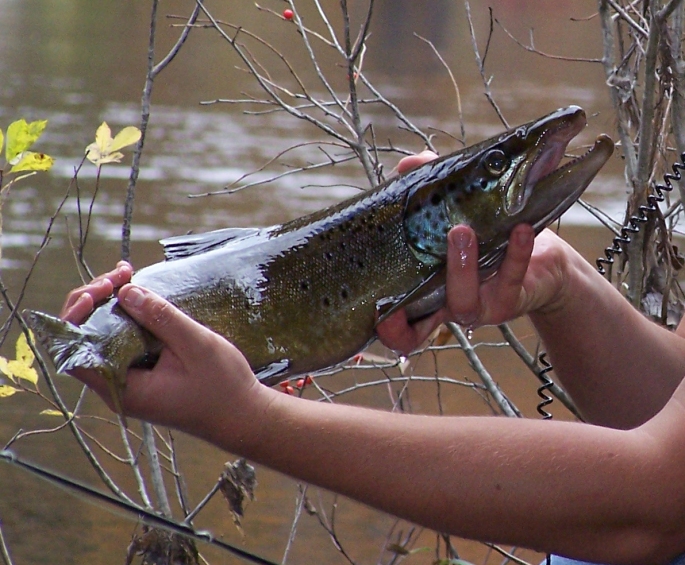
Trout fishing is fun and exciting. It is a perfect family outdoor activity. Here is some general Trout fishing tips and information that you will find useful.
There are many factors affecting the number of trout you will catch in your fishing trip. The trout's feeding habits, the temperature of the water, and the time of feed will determine if you will have a good fishing day.
There are four main types of trout - Brown Trout, Cutthroat Trout, Brook Trout, and the all time favorite, Rainbow Trout. Trout likes moving water, therefore, trout fishing is best done in rivers and streams. However, you can also go trout fishing at the lakes.
The difficult part in trout fishing is try catching big trout. It is not as difficult to catch small trout. Everyone has their own trout fishing methods. Some people say using a float works best for them when catching trout. Others swear by fly fishing. In any event, what matters is to find a method that works best for you.
Trout Fishing Bait
Most people have a favorite trout fishing bait. However, there are times when your favorite bait is not working, be prepared to try another bait as well. Fish are similar to all other animals. If they keep feeding on one thing for a long time, they might be more attracted to something different. Be sure to keep a variety of bait with you, so that if one type is not working, you can switch to something else. Insects, earthworms, spinners, minnows, salmon eggs, and crayfish are examples of good bait. Some of the flies you can find in the fishing supply store do not look like insects at all. What matters to the trout is that the fly should be similar a tasty morsel of food.
Trout Fishing Line
It is important to find the right Fishing Line as well. Thin fishing line works better for trout fishing. The heavier the line is, the more likely the fish would spot it and be put off.
Trout Fishing Techniques
Of all the trout fishing techniques, many anglers like trolling. Trolling is simple enough for the most beginning anglers, and yet a favorite of many experienced ones. Trolling is letting the line out the back of the boat and propelling the boat in front. The propulsion can either be motor or through the use of oars. You do not have to move too fast. Moving too fast might discourage the trout from going after the bait.
It is important to have the right trout fishing equipment. This includes a rod, a reel, and a net. Do not use a rod that is too heavy because it is hard to detect fish. Make sure to match the line with the rod weight and keep a durable net when you go trout fishing.
Trout fishing is a fun activity for all ages. Using the right trout fishing technique, the right equipment, and the right lures will turn your trout fishing moments into fond memories.


Facts about Trouts
The rainbow trout is native only to the rivers and lakes of North America, west of the Rocky Mountains, but its value as a hard-fighting game fish and tasty meal has led to its introduction throughout the world.
Rainbow trout, also called redband trout, are gorgeous fish, with coloring and patterns that vary widely depending on habitat, age, and spawning condition. They are torpedo-shaped and generally blue-green or yellow-green in color with a pink streak along their sides, white underbelly, and small black spots on their back and fins.
They are members of the salmon family and, like their salmon cousins, can grow quite large. They average about 20 to 30 inches (51 to 76 centimeters) long and around 8 pounds (3.6 kilograms), but can grow as long as 4 feet (1.2 meters) and weigh up to 53 pounds (24 kg).
They prefer cool, clear rivers, streams, and lakes, though some will leave their freshwater homes and follow a river out to the sea. These migratory adults, called steelheads because they acquire more silvery markings, will spend several years in the ocean, but must return to the stream of their birth to spawn.
Rainbow trout survive on insects, crustaceans, and small fish. Their populations are healthy worldwide and they have no special status or protections. However, they are now considered a non-native pest species in some areas where they have been introduced.






 Trout are not native to Australian waterways; they originally come from North America. They were translocated to Australia as a recreational species in 1942. They are cold water fish, needing temperatures between 10-15oC. They can be grown in N.S.W. during winter, however it is suggested that they are purchased as advanced fingerlings (10cm) so that they can plate size of 200-250g during the winter timeframe.
Trout are not native to Australian waterways; they originally come from North America. They were translocated to Australia as a recreational species in 1942. They are cold water fish, needing temperatures between 10-15oC. They can be grown in N.S.W. during winter, however it is suggested that they are purchased as advanced fingerlings (10cm) so that they can plate size of 200-250g during the winter timeframe.